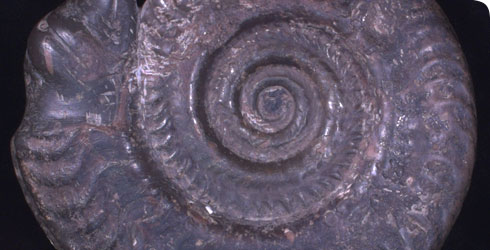Hildoceras bifrons
Hildoceras bifrons is an ammonoid that lived in the Early Jurassic Period, and became extinct about 175 million years ago.
H. bifrons is known as a ‘zone fossil’ - a fossil which has a precise distribution within layers of rock, and which can be used to identify layers of the same age.
The Hildoceras genus is named in honour of St. Hilda of Whitby (614-680 AD), whose feast day is celebrated on 17th November by the Roman Catholic Church.
Hildoceras ammonites are common along the Yorkshire coast, and are sometimes referred to as ‘snakestones’ due to ancient folklore that explained their origin as follows:
In the legend, St. Hilda was given the task of founding an Abbey on the plains of Whitby, but the area was infested with snakes. Snakes were seen as devilish and it was important to cast them out before creating a sacred building. St. Hilda prayed and after a short time the snakes coiled up and turned to stone, she then threw them off the cliff and that is why these creatures are found in the rocks around Whitby.
The absence of heads on the ammonite fossils is sometimes attributed to a further curse by St. Cuthbert.
In order to accentuate this belief, it was common in Victorian times, for fossil dealers to carve a snake’s head on ammonite fossils, in particular the species Hildoceras and Dactylioceras.
Species detail
Hildoceras bifrons has:
- a flattened spiral shape
- evolute whorls
- a rounded umbilical edge
- a tricarinate and bisulcate venter with a strong central keel
- a well-marked spiral groove which runs around the side of the whorl
-

Biology
This ammonite species had a characteristic shell. Take a closer look.
-

Taxonomy
This ammonite species had a characteristic shell. Take a closer look and find out more about the evolution of this family.
-

Distribution
These ammonoids lived in oceans alongside a variety of other animals that provided a rich food source. Hildoceras bifrons fossils are commonly found in fine marine sediments. Find out where.
-

Conservation
Hildoceras bifrons fossils are commonly found in sea cliff exposures of the Whitby Mudstone Formation in northern England.
-

References
Find references for Hildoceras bifrons.
Author
Lindsay Percival
Department of Palaeontology
Toolbox
Glossary
Nekton is a free-swimming animals
Evolute and involute are geometrical terms relating to the shape of a curve
Lappets are spoon shaped extensions from the margin of the aperture
Arcuate is curved
Striae are fine lines of ornament
Ventro-lateral keels are ridges (keels) located on the sides of the venter
Tricarinate and bisulcate are two grooves separating the has three ridges (keels)of the venter.
Venter is the shell edge around the circumference
